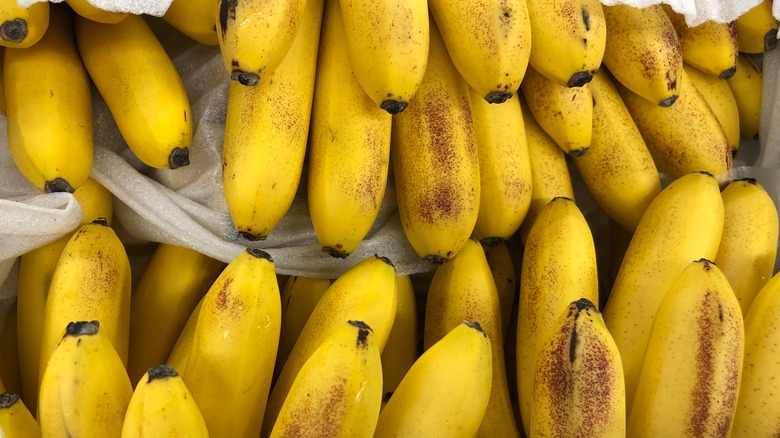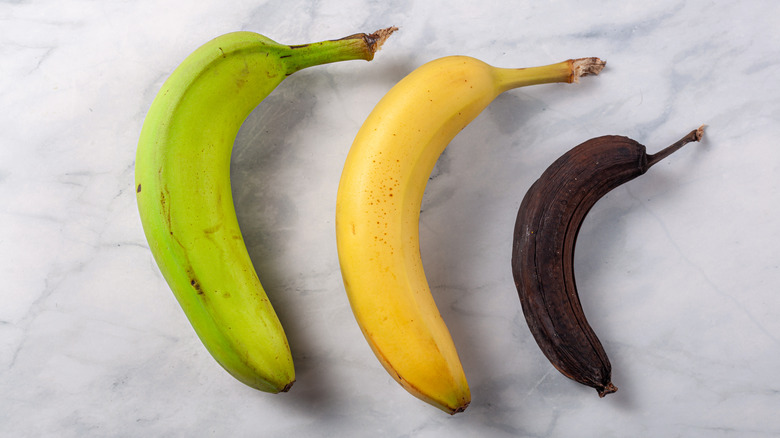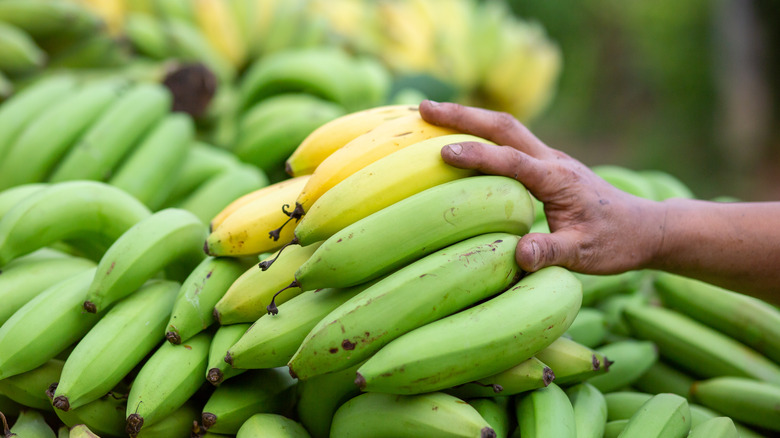The Scientific Way Producers Ensure Bananas Are Perfectly Ripe At The Store
It's not uncommon to go to the grocery store and see a display full of green bananas, leaving you no choice but to bring 'em home and wait it out until they're ready to eat. OR, on the other hand, there's no green in sight and the shelf is full of brown speckled bananas. Whichever level of ripeness you prefer, isn't it odd to think that every bunch looks the same? The entire shelf could come from different plants in different places, so why do they seem to ripen at the exact same time? We smell some type of fruit manipulation going on.
According to NPR, ethylene is a gaseous hormone found in bananas (and other fruits) that, in the early stages, present low levels. As bananas begin to ripen, however, levels of ethylene surge, taking your afternoon snack from slightly sour with hints of green to fully yellow with extra sweetness, and eventually completely brown and mushy enough for a batch of banana bread. The outlet explains that a ripening switch approach has been practiced and executed in many, if not all, distribution centers, to ensure perfect produce at the time of arrival to stores.
Controlling the release of ethylene
How producers can now ensure bananas and other fruit are perfectly ripe at the store all started with hormonal regulation. The rate of ethylene release had been a mystery, and climacteric fruit farming (i.e., fruit that can continue to mature even after it's been picked, like bananas, per MSU Extension) had become a risky business for producers with unpredictable products. This led scientists to get involved. If we can't predict, can we control?
According to Nature Plants, we can. In order for farmers to give grocery stores the best quality of bananas, they had to control the ethylene, which means purposely harvesting unripe fruit, storing it, and exposing it to synthetic ethylene upon shipping so that the product maintains shelf-life and would be on its way to yellow by the time it hits the produce section.
Harvesting fruit like bananas when unripe is essentially catching them at a time when ethylene is being released at an extremely slow rate. However, harvesting bananas and other climacteric fruit when ripe calls for rapid release of the hormone and even faster decay. Ethylene is a stress-responsive hormone (per Frontiers in Plant Science), with a goal to deteriorate whatever it's exposing.
Whichever way you like your banana typically means you found it at just the right time, seeing that ethylene is breaking down that fruit more and more until it eventually turns to brown mush. For those who like bananas with brown specks yet can only find them green, don't you wish you had your own synthetic ethylene at home? Well, think again. There are risks involved when it comes to this gaseous hormone.
Perfect conditions lead to perfectly ripe bananas
From the time bananas are harvested until they reach distribution centers, it's crucial that they're transported in a cold, ventilated trailer to put a halt on ethylene release and maintain that lime green banana hue (via ThirdLeaf NW). Once the bananas reach the distribution centers, they go into something called "banana elevators," which is where they're treated with ethylene in a controlled space at rapid rates.
Keeping this targeted release confined to small spaces like the elevators helps prevent emitting ethylene carelessly, which, according to NPR, can be dangerous due to the hormone's flammability. Once ripe, distributors send the bananas out to stores. From then on, it is best to keep your bananas stored between 56 and 58 degrees Fahrenheit (via SEMCO).
While a controlled release of ethylene cheats the system of a natural cycle of ripening, without it, we'd be left with either rock-hard lime green or brown and mushy bananas. We as people would prefer somewhere in between, and because of the ripening switch, we have the privilege of being picky.


